What You Should Know
What You Will Learn
- Easy first position chords
- Tips for learning new chords
Easy Guitar Chords for Beginners
Chords in the first position are the basis of many well known songs. These chords are found around the first few frets of the guitar and generally include some open strings. Learning these chords is the first step toward playing thousands of songs in a variety of keys and styles.
Learning Chords
Pay close attention to the fingering for each chord. Many beginners try to use fingerings other than the standard fingerings, but this is generally a bad idea. There is also a tendency to avoid the pinky because it is usually the weakest finger. This leads to fingerings that are awkward and possibly puts you at risk of injury. If you find a chord too difficult, skip it for now and work on chords that you find easier. You can come back to any chords you find challenging once your fingers are ready. Practicing the easier chords will prepare you for those that you find difficult.
Practice each chord for a few minutes each day until you can play them cleanly. Use the tips in the introduction to chords to help you. The chords below are listed in approximate order of difficultly.
The Chords
E Major Chord
Chord Diagram

Tablature
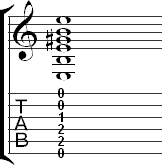
C Major Chord
Chord Diagram

Comments
This chord will be difficult if you don't keep your thumb behind the neck. Make sure your middle finger doesn't mute the third string and watch the index finger so that it doesn't mute the first string.
Tablature
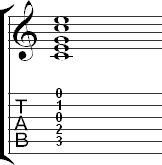
A Minor Chord
Chord Diagram

Comments
A minor has the same shape as the E major chord, but moved down a string.
Tablature
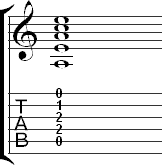
D Major Chord
Chord Diagram

Comments
Watch your ring finger to make sure it doesn't mute the first string. This is a common problem when first learning D major.
Tablature
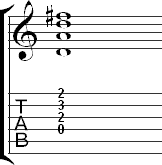
D Minor Chord
Chord Diagram

Comments
Avoid using the ring finger in place of the pinky on the third fret of the second string. Using the ring finger would require a greater stretch and possibly require an awkward hand position.
Tablature
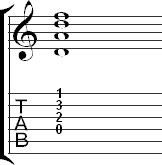
Below are two different versions of the G major chord. Both are used frequently, so learn both of them.
Version One - G Major Chord
Chord Diagram

Comments
Resist the temptation to use the ring finger instead of the pinky on the first string. Using the pinky reduces the stretch of the chord and will make switching between certain chords easier. Avoid muting the D string with your index finger.
Tablature
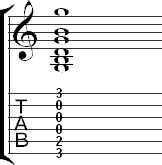
Version Two - G Major Chord
Chord Diagram

Comments
This is another common way of playing G major. The only difference with version one is that the ring finger is placed on the third fret of the second string. This version sounds better for rock music, while the first version is more often found in folk music.
Tablature
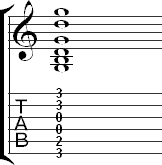
A Major Chord
Chord Diagram

Comments
The A major chord is somewhat awkward because of the closeness of the fingers at the second fret. The fingering shown is the best fingering for most people since it mitigates the closeness of the notes to some degree. However, the chord can also be fingered by placing the index finger on the fourth string, the middle finger on the third string, and the ring finger on the second string. Try both fingerings and use the one that feels best to you.
Tablature
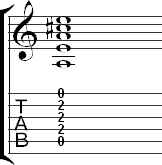
F Major Chord
Chord Diagram

Comments
F major is often the most difficult first position chord for a beginner. The index finger has to play two strings at once. This is difficult by itself, but the position of the index finger also makes the stretch to play the other notes in the chord somewhat challenging. Getting a clean sound requires experimentation with the position of the arm and fingers.
Tablature
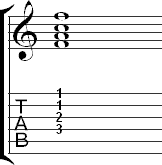
Below is an exercise that breaks the F major chord down so that you can gradually develop the stretch required to play it. Make sure you use the indicated fingerings.

You can start learning to change between chords before mastering the F major chord, but the other chords in this lesson should be comfortable before starting the next lesson.

Comments
This chord should be very easy. Only one note changes from the E minor chord you learned previously. You only need to add your index finger on the first fret of the third string to change E minor to E major. If you want, start by fingering E minor chord and then add the index finger on the third string to make it E major.